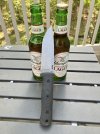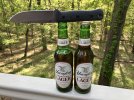the Bravo already arrived yesterday! ... that was quick. I ordered it last Wed from DLT Trading, and it took just 5 days to get it shipped, to down under, through custom and to my front door. All for a very attractive price.
After all the reading about the quality issues other experienced - and somehow confirmed by the Dutch Bushcraft guys, who, as diehard BR fanboys, complaint about quality issues and long lead times to get replacement knifes - I was a little bit nervous. But! ....the knife arrived in impeccable condition. I just couldn't find any flaw! The packaging was quite simple - and I like this as I hate having to pay for a shiny box! It is - out of the box - "kitchen paper roll" sharp. The shiny black canvas Micarta, the simple shaped convex blade - this is IMO a timeless classic.
The handle could have a little bit more volume for my taste; it is not a bad handle, and I have normal sized hands, but most of the knifes I use have "bulkier" handles - it may take some time to get used to it. While I admit that the grinded Corby bolt fasteners look good and shiny, I still prefer bolts respectively scales that I can remove easily - makes it easier to check the tang, remove the scales for more serious sharpening works to avoid any scale damage, replace the scales if needed, or just to engrave your name so you can prove that it is yours.
The convex blade / edge is very acute - I tried feather sticking with Australian hardwood....and the performance was excellent; this might be my best feather sticker from all my knifes.
However, I would be very careful with this edge when hard batoning dried hardwood - you can't have the cake and eat it. (This reminds me of the sometimes very unscientific approach of the Dutch Bushcraft guys: in this video
they changed the edge of the Bronco from a V-edge that gave the knife an average sharpness to a fine convex with a much better sharpness - and then they hammered the edge on the rim of and old rusty metal drum and compared the "not-so-good" performance with knifes that performed much better in this "test". I'm pretty sure that the Bronco would have performed much better with the original v-edge.)
Overall, the Bravo (Bravo 1.25 LT 3V rampless in black canvas Micarta) is pretty much exactly what I was looking for. Exactly the size I wanted with all the high-quality attributes (material, finish, handle ergonomics...). Only the sheath is not my first choice when it comes to sheath design, but I knew this before and it is about the knife, not the sheath. (It is not so bad, actually better useable than I thought.)
Will it be better than the Reiff F5 (I will get it in a few days)? ....based on the data I assume the F5 with the V-edge (20 deg angle per side - I got this confirmed by Reiff), and longer and bulkier handle will perform better with batoning dry hardwood and any other tougher tasks - the potential better HT might also help to give F5 the edge wrt toughness. And it has removable handles - function before looks! The Bravo will likely have the edge for typical "bushcraft" tasks (feather sticking, slicing, carving....).
I wanted one "dream" knife that can do it all, that is not too big and not too heavy, big enough to do the various jobs, but small enough so I can carry it in the side pockets of my trousers, with high quality steel and finish - looks now I will end up having 2 instead of just one..... I love to have this kind of problems in these times

Eta: ...spelling...
)




